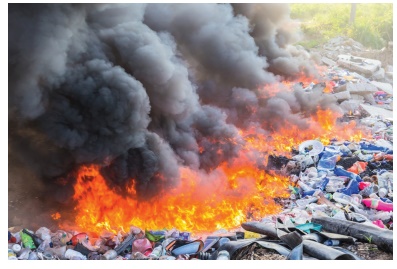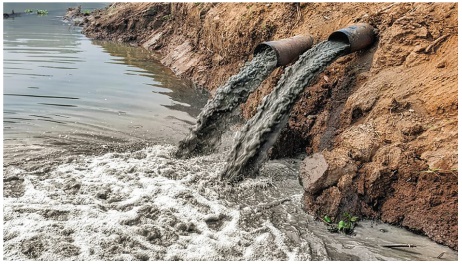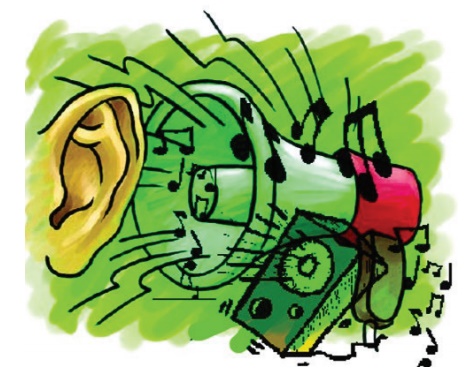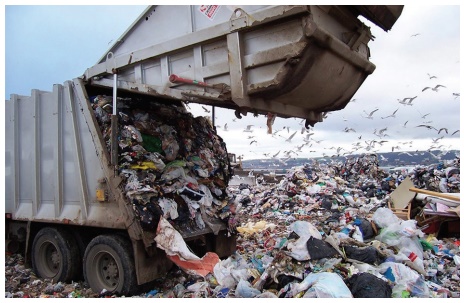Types, Meaning - Environmental Economics - Pollution | 12th Economics : Chapter 10 : Environmental Economics
Chapter: 12th Economics : Chapter 10 : Environmental Economics
Pollution
Pollution
Meaning
Pollution is the introduction of contaminants into the natural
environment that causes adverse change, in the form of killing of life, toxicity
of environment, damage to ecosystem and aesthetics of our surrounding.
Types of Pollution
1. Air pollution
2. Water pollution
3. Noise pollution
4. Land pollution
1. Air Pollution

Definition
“Air pollution is the presence of any solid, liquid, or gaseous
substance in the atmosphere in such concentration as may be or tend to be
injurious to human beings or other living creatures or plants or property
or environment”. -The Air (Prevention and Control of Pollution) Act, 1981
Types of Air pollution
a) Indoor Air Pollution: It refers to toxic contaminants that we
encounter in our daily lives in our homes, schools and workplaces. For example,
cooking and heating with solid fuels on open fires or traditional stoves
results in high levels of indoor air pollution.
b) Outdoor Air Pollution: It refers to ambient air. The common
sources of outdoor air pollution are caused by combustion processes from motor
vehicles, solid fuel burning and industry.
Causes of Air Pollution
1. Vehicleexhaustsmoke: Vehicles smoke happens to release high
amounts of Carbon monoxide. Millions of vehicles are operated every day in
cities, each one leaving behind its own carbon footprint on the environment.
2. Fossil fuel based power plants: Fossil fuels also present a wider
scale problem when they are burned for energy in power plants. Chemicals like
sulfur dioxide are released during the burning process, which travel straight
into the atmosphere. These types of pollutants react with water molecules to
yield something known as acid rain.
3. Exhaust from Industrial Plants and Factories: Heavy machineries
located inside big factories and industrial plants also emit pollutants
into the air.
4. Construction and Agricultural activities: Potential impacts
arising from the construction debris would include dust particles and
gaseous emissions from the construction sites. Likewise, using of ammonia for
agriculture is a frequent byproduct that happens to be one of the most
dangerous gases affecting air.
5. Natural Causes: Earth is one of the biggest polluters itself,
through volcanoes, forest fires, and dust storms. They are nature-borne events
that dump massive amounts of air pollution into the atmosphere.
6. Household activities: Household activities like cooking,
heating and lighting, use of various forms of mosquito repellents, pesticides
and chemicals for cleaning at home and use of artificial fragrances are some of
the sources that contribute to air pollution.
Effects of Air Pollution
1. Respiratory and heart problems: It creates several
respiratory and heart ailments along with cancer. Children are highly
vulnerable and exposed to air pollutants and commonly suffer from pneumonia and
asthma.
2. Global warming: Increasing temperature in the
atmosphere leads to global warming and thereby to increase sea level rise and
melting of polar icebergs, displacement and loss of habitat.
3. Acid rain: Harmful gases like nitrogen oxides and
sulfur oxides are released into the atmosphere during the burning of fossil
fuels. Acid rain causes great damage to human beings, animals and crops.
4. Eutrophication: Eutrophication is a condition where
high amount of nitrogen present in some pollutants which adversely affects
fish, plants and animal species.
5. Effect on Wildlife: Toxic chemical present in the air
can force wildlife species to move to new place and change their habitat.
6. Depletion of Ozone layer: Ozone exists in earth’s
atmosphere and is responsible for protecting humans from harmful ultraviolet
(UV) rays. Earth’s ozone layer is depleting due to presence of
chlorofluorocarbons and hydro chlorofluorocarbons in the atmosphere.
7. Human Health: Outdoor air pollution is a major cause of death and disease globally. The health effects range from increased hospital admissions and emergency room visits, to increased risk of premature death. An estimated 4.2 billion premature deaths globally are linked to ambient air pollution.
Remedial measures to control Air Pollution
1.
Establishment of industries away from the towns and cities
2.
Increasing the length of the Chimneys in industries
3.
Growing more plants and trees
4.
Use of non-conventional fuels like Biogas, CNG and LPG.
5.
Use of Mass Transit System (Public Transport)
2. Water Pollution
Definition
“The introduction (directly or indirectly) of substances or energy
into the marine environment (including estuaries) results in deleterious
effects to living resources, hazards to human health, hindrance to marine
activities. - United Nations, 1971

Types of Water Pollution
1. Surface water pollution: Surface water includes natural water
found on the earth’s surface, like rivers, lakes, lagoons and oceans. Hazardous
substances coming into contact with this surface water, dissolving or mixing physically
with the water can be called surface water pollution.
2. Ground water pollution:Groundwater contamination
occurs when man-made products such as gasoline, oil and chemicals get into the
ground water. In addition, untreated waste from septic tanks, toxic chemicals
from underground storage tanks and leaky landfills contaminate groundwater.
3. Microbiological pollution: In many communities around the world,
people drink untreated water (straight from a pond,river or stream). Sometimes
there is natural pollution caused by micro-organism like viruses and bacteria.
This natural pollution causes both aquatic and human illness.
4. Oxygen depletion pollution: When oxygen levels in the water are
depleted, relatively harmless aerobic micro-organisms die and anaerobic
micro-organisms begin to thrive. Some anaerobic micro-organisms are harmful to
people, animals and the environment as they produce harmful toxins such as
ammonia and sulfides.
Causes of Water Pollution
Water pollution is caused due to several reasons. Here are the few
major causes of water pollution:
1. Discharge of sewage and waste water: Sewage, garbage
and liquid waste of households, agricultural runoff and effluents from
factories are discharged into lakes and rivers. These wastes contain harmful
chemicals and toxins which make the water poisonous for aquatic animals and
plants.
2. Dumping of solid wastes: The dumping of solid wastes and litters
in water bodies cause huge problems.
3.. Discharge of industrial sastes: Industrial
waste contains pollutants like asbestos, lead, mercury, grease oil and
petrochemicals, which are extremely harmful to both people and environment.
4. Oil Spill: Sea water gets polluted due to oil spilled
from ships and tankers while travelling. The spilled oil does not dissolve in
water and forms a thick sludge polluting the water.
5. Acid rain: Acid rain is pollution of water caused by
air pollution. When the acidic particles caused by air pollution in the
atmosphere mix with water vapor, it results in acid rain.
6. Global warming: Due to global warming,
there is an increase in water temperature as a result aquatic plants and
animals are affected.
7. Eutrophication: Eutrophication is an increased level
of nutrients in water bodies. This results in bloom of algae in water. It also
depletes the oxygen in water which negatively affects fish and other aquatic
animal population.
Effects of Water Pollution
Water pollution adversely affects the health and life of man,
animals and plants alike. Polluted water is also harmful for agriculture as it
adversely affects the crops and the soil fertility. Pollution of sea water
damages the oceanic life. The effects can be catastrophic, depending on the
kind of chemicals, concentrations of the pollutants. The effects of water
pollution are varied and depend on what chemicals are dumped and in which
locations. Many water bodies near urban areas are highly polluted. This is the
result of both garbage dumped by individuals and dangerous chemicals legally or
illegally dumped by manufacturing industries, health centers and markets.
i. Death of aquatic animals: The main problem caused by water pollution is that it
kills organisms that depend on these water bodies. Dead fish, crabs, birds and
sea gulls, dolphins, and many other animals often wind up on beaches, killed by
pollutants in their habitat.
ii. Disruption of food-chains: Pollution disrupts the natural food chain as well.
Pollutants such as lead and cadmium are eaten by tiny animals. Later, these
animals are consumed by fish and the food chain continues disrupted at all
higher levels.
iii. Diseases: The discharge of untreated and under-
treated effluent contributes to severe ecological degradation. The
indiscriminate human activities such as open defecation, solid waste dumping,
discharge of drainage water are responsible for the pathogenic bacteria
water-borne diseases like Hepatitis-A, Typhoid, Malaria, Dysentery, Jaundice,
Dengue fever, Viral fever and Worm infections.
iv. Destruction of Ecosystems: Ecosystems
can be severely destroyed by water pollution. Many areas are now being affected
by careless human pollution, and this pollution is coming back to hurt humans
in many ways.
Remedial measures to control Water Pollution
1. Comprehensive water management plan.
2. Construction of proper storm drains and settling ponds.
3. Maintenance of drain line.
4. Effluent and sewage treatment plant.
5. Regular monitoring of water and waste water.
6. Stringent actions towards illegal dumping of waste into the
water bodies.
3. Noise Pollution

Definition
Noise pollution is unwanted or excessive sound that can have
deleterious effects on human health and environmental quality. Noise pollution
is commonly generated by many factories. It also comes from highway, railway
and airplane traffic and from outdoor construction activities. -Jerry A. Nathanson and
Richard E. Berg, 2018
Types of Noise Pollution
i. Atmospheric Noise: Atmospheric noise or static is caused by
lighting discharges in thunderstorms
and other natural electrical disturbances occurring in the atmosphere.
ii. Industrial Noise: Industrial noise refers
to noise that is created in the factories. Sound becomes noise it becomes
unwanted. Heavy industries like ship building, iron and steel have long been
associated with Noise Induced Hearing Loss (NIHL).
iii. Man made Noise: The main sources of man-made noise
pollution are ships, aircraft, seismic exploration, marine construction,
drilling and motor boats.
Causes of Noise Pollution
i. Poor urban planning: Improper urban planning will cause more nuisances among the
city travelers.
ii. Sounds from motor vehicles: Sounds from motor vehicles can cause temporary
hearing loss.
iii. Crackers: Enormous Crackers are used during some occasions. Such
activities create a very louder noise to the level of harming the public.
Sometimes, they may even cause deafness to children and aged.
iv. Factory machinery: The industrial noise caused by continuous
operation of mills, machines and pneumatic drills, is unbearable nuisance to
the workers.
Effects of Noise Pollution
a. Hearing Loss: Chronic exposure to noise may cause
noise -induced hearing loss. Older people are exposed to significant
occupational noise and thereby reduced hearing sensitivity.
b. Damage Physiological and Psychological health: Unwanted
noise can damage physiological and psychological health. For example, annoyance
and aggression,hypertension, and high stress levels.
c. Cardiovascular effects: High noise levels can contribute to
cardiovascular problems and exposure to blood pressure.
d. Detrimental effect on animals and aquatic life: Noise can have a
detrimental effect on animals, increasing the risk of death.
e. Effects on wildlife and aquatic animals: It creates hormone
imbalance, chronic stress, panic and escape behavior and injury.
Remedial measures to control Noise Pollution
1.
Use of noise barriers
2.
Newer roadway for surface transport
3.
Traffic control
4.
Regulating times for heavy vehicles
5.
Installations of noise barriers in the work place
6.
Regulation of Loudspeakers
4. Land Pollution

Definition
The land pollution is defined as, “the degradation of land because
of the disposal of waste on the land”. Any substance (solid, liquid or gaseous)
that is discharged, emitted or deposited in the environment in such a way that
it alters the environment causes land pollution -Protection of the Environment
Operations Act 1997
Types of Land Pollution
i. Solid waste: It includes all kinds of rubbish like paper, plastic
containers, bottles, cans, food, used cars, broken electronic goods, municipal
waste and hospital waste.
ii. Pesticides and Fertilizers: Many farming activities engage in the
application of fertilizers, pesticides and insecticides for higher crop yield
which pollute land.
iii. Deforestation: Humans depend on trees for many things
including life. Trees absorb carbon dioxide from the air and release Oxygen,
which is needed for life. Forest helps replenish soils and help retain
nutrients being washed away. Deforestation is led to land pollution.
Causes of Land Pollution
i. Deforestation and soil erosion: Deforestation
carried out to create dry lands is one of the major concerns. Land that is once
converted into a dry or barren land, can never be made fertile again, whatever
the magnitude of measures to convert it.
ii. Agricultural activities: With growing human and pet
animal population, demand for food has increased considerably. Farmers often
use highly toxic fertilizers and pesticides to get rid off insects, fungi and
bacteria from their crops. However the overuse of these chemicals, results in
contamination and poisoning of land.
iii. Mining activities: During extraction and mining
activities, several land spaces are created beneath the surface.
iv. Landfills : Each household produces tones of garbage
each year due to changing economic lifestyle of the people. Garbage like
plastic, paper, cloth, wood and hospital waste get accumulated. Items that
cannot be recycled become a part of the landfills that cause land pollution.
v. Industrialization: Due to increasing consumerism more
industries were developed which led to deforestation. Research and development
paved the way for modern fertilizers and chemicals that were highly toxic and
led to soil contamination.
vi. Construction activities: Due to urbanization,
large amount of construction activities are taking place. This has resulted in
large waste articles like wood, metal, bricks, plastic. These are dumped at the
outskirts of urban areas that lead to land pollution.
vii. Nuclear waste: The leftover radioactive materials,
harmful and toxic chemicals affect human health. They are dumped beneath the
earth to avoid any casualty.
Effects of Land Pollution
1. Soil pollution: Soil pollution is another form of land
pollution, where the upper layer of the soil is damaged. This is caused by the
overuse of chemical fertilizers, and pesticides. This leads to loss of fertile
land. Pesticides kill not only pests and also human beings.
2. Health Impact: The land when contaminated
with toxic chemicals and pesticides lead to problem of skin cancer and human
respiratory system. The toxic chemicals can reach our body through foods and
vegetables.
3. Cause for Air pollution : Landfills and waste dumping
lead to air pollution. The abnormal toxic substances spread in the atmosphere
cause transmit respiratory diseases among the masses.
4. Effect on wildlife: The animal kingdom
has suffered mostly in the past decades. They face a serious threat with
regards to loss of habitat and natural environment. The constant human activity
on land is leaving it polluted, forcing these species to move farther away.
Sometimes several species are pushed to the verge of extinction or disappear
due to no conducive environment.
Remedial measures to control Land Pollution
i.
Making people aware about the concept of a Reduce, Recycle and
Reuse
ii.
Buying biodegradable products
iii.
Minimizing the usage of pesticides
iv.
Shifting cultivation
v.
Disposing unwanted garbage properly either by burning or by
burying under the soil.
vi.
Minimizing the usage of plastics.
Related Topics